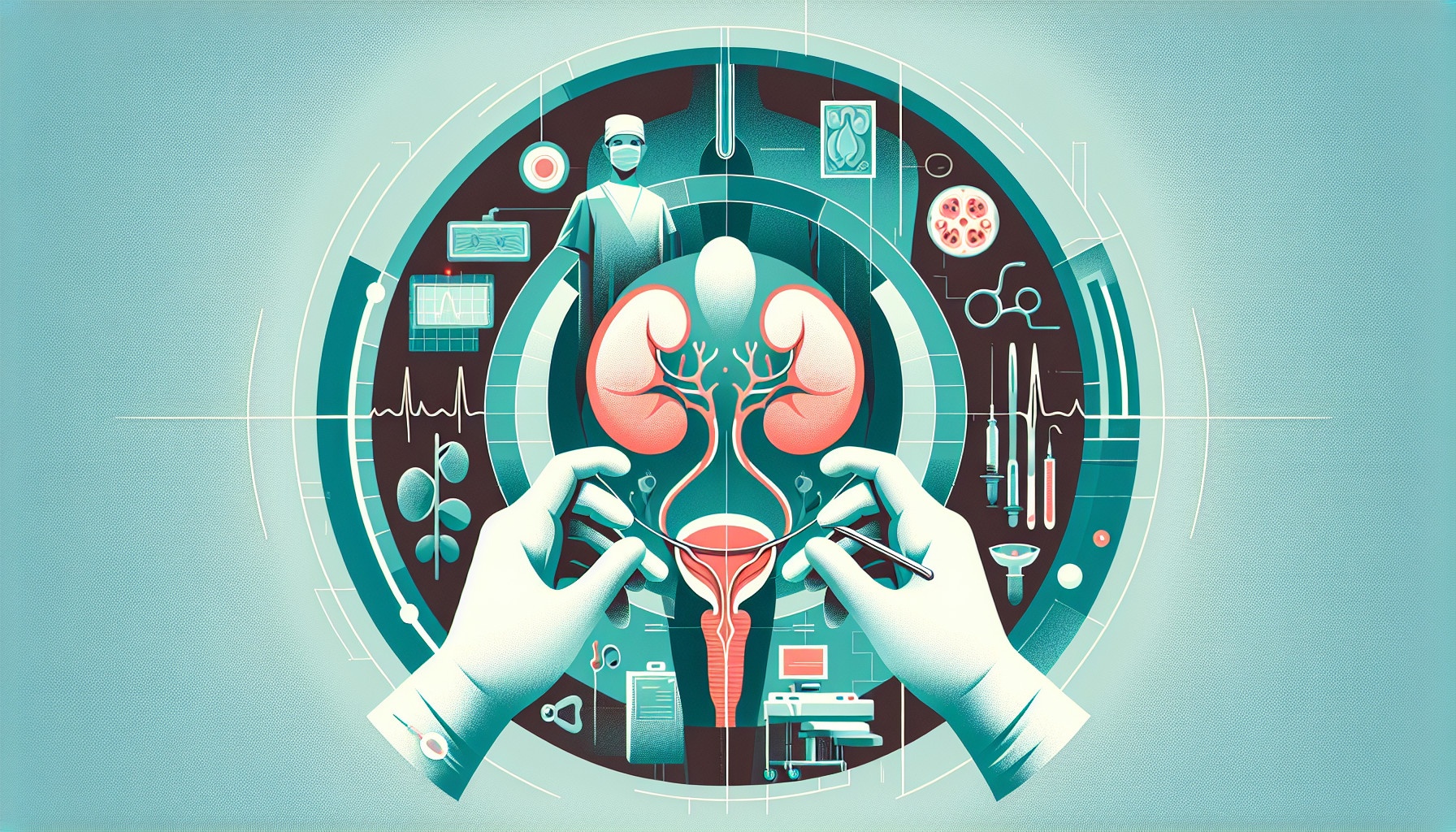Our Summary
This research aims to find a better way to fix large defects in the urinary bladder wall. Currently, doctors use parts of the intestine to mend these defects, but this method often causes complications. The researchers looked into using a material called bladder acellular matrix (BAM) instead. To do this, they removed all the cells from bladder tissue, leaving behind a scaffold-like structure that can be used to rebuild the bladder wall.
They tested this method on 10 female pigs. After removing part of the bladder (hemicystectomy) and replacing it with BAM, they monitored the pigs for 6 months. Six of the pigs survived the entire observation period, while the other four died due to complications related to the scaffold, the connection between the scaffold and the original bladder tissue, or a blocked catheter.
The pigs that survived did not show any signs of leftover urine in their bladder or urinary tracts after voiding. Visually, the grafts appeared to have shrunk. The inner surface of the graft was completely covered by urothelium, the tissue that normally lines the bladder. The researchers also saw signs of regeneration in the smooth muscle tissue, especially around the edges of the graft.
However, the reconstructed bladder wall had lower levels of markers for urothelial cells, smooth muscle cells, blood vessels, and nerves compared to a normal bladder. This suggests that while BAM is a promising material for bladder reconstruction, more research is needed to improve the regeneration process.
FAQs
- What is the current method for fixing large defects in the urinary bladder wall and why is a new method needed?
- What is bladder acellular matrix (BAM) and how is it used in bladder reconstruction?
- What were the findings and implications of the study that used BAM for bladder reconstruction in pigs?
Doctor’s Tip
One helpful tip a doctor might tell a patient about bladder surgery using BAM is to follow post-operative care instructions carefully, including staying hydrated, avoiding heavy lifting or strenuous activity, and attending follow-up appointments to monitor healing and address any concerns promptly. It is also important to communicate any changes in symptoms or discomfort to your healthcare provider to ensure a successful recovery.
Suitable For
Patients who may be recommended bladder surgery include those with:
- Large defects in the urinary bladder wall that cannot be repaired through other methods
- Chronic bladder conditions such as interstitial cystitis or recurrent bladder infections
- Bladder cancer or other bladder tumors that require surgical removal
- Bladder dysfunction or urinary incontinence that does not respond to other treatments
- Bladder diverticula, which are pouches that form in the bladder wall and can cause urinary symptoms
- Bladder prolapse, where the bladder drops or protrudes into the vagina
- Bladder stones that cannot be removed through other means
It is important for patients to discuss their specific condition and treatment options with their healthcare provider to determine if bladder surgery is necessary and appropriate for their individual situation.
Timeline
Pre-surgery: The patient experiences symptoms such as urinary incontinence, frequent urinary tract infections, or difficulty emptying the bladder. They consult with a urologist who recommends bladder surgery to repair the large defect in the bladder wall.
Surgery: The patient undergoes bladder surgery, during which the damaged portion of the bladder wall is removed and replaced with bladder acellular matrix (BAM). The surgery is performed under general anesthesia and typically lasts a few hours.
Post-surgery: The patient is monitored in the hospital for complications such as infection, bleeding, or urine leakage. They may need to use a catheter for a period of time to help drain urine from the bladder.
Recovery: The patient is discharged from the hospital and continues to recover at home. They may experience pain, discomfort, and urinary urgency during this time. Follow-up appointments with the urologist are scheduled to monitor the healing process.
Long-term follow-up: The patient undergoes regular check-ups with the urologist to ensure the bladder is functioning properly and to monitor for any signs of complications. Additional treatments or surgeries may be needed if issues arise.
Overall, the patient’s experience before and after bladder surgery involves consultation with a urologist, undergoing the procedure, recovering from surgery, and long-term follow-up to ensure the success of the bladder reconstruction.
What to Ask Your Doctor
What are the potential risks and complications associated with bladder surgery using bladder acellular matrix (BAM)?
How long is the recovery time expected to be after bladder surgery with BAM?
Will I need to undergo any additional procedures or treatments after the bladder surgery with BAM?
How successful has this method been in treating large defects in the urinary bladder wall in other patients?
Are there any specific lifestyle changes or precautions I should take after bladder surgery with BAM?
What is the expected outcome in terms of bladder function and overall quality of life after the surgery?
Are there any long-term effects or considerations I should be aware of following bladder surgery with BAM?
How often will I need to follow-up with my doctor after the surgery to monitor my progress and any potential complications?
Are there any alternative treatment options available for repairing large defects in the urinary bladder wall besides using bladder acellular matrix?
How experienced is the surgical team in performing bladder surgery with BAM, and what is their success rate with this procedure?
Reference
Authors: Pokrywczynska M, Jundzill A, Tworkiewicz J, Buhl M, Balcerczyk D, Adamowicz J, Kloskowski T, Rasmus M, Mecinska-Jundzill K, Kasinski D, Frontczak-Baniewicz M, Holysz M, Skopinska-Wisniewska J, Bodnar M, Marszalek A, Antosik P, Grzanka D, Drewa T. Journal: J Biomed Mater Res B Appl Biomater. 2022 Feb;110(2):438-449. doi: 10.1002/jbm.b.34920. Epub 2021 Jul 29. PMID: 34323358
